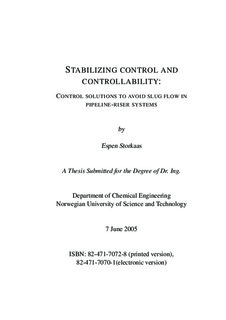| dc.contributor.author | Storkaas, Espen | nb_NO |
| dc.date.accessioned | 2014-12-19T13:22:50Z | |
| dc.date.available | 2014-12-19T13:22:50Z | |
| dc.date.created | 2008-04-09 | nb_NO |
| dc.date.issued | 2005 | nb_NO |
| dc.identifier | 124002 | nb_NO |
| dc.identifier.isbn | 82-471-7070-1 | nb_NO |
| dc.identifier.uri | http://hdl.handle.net/11250/248076 | |
| dc.description.abstract | Riser slugging is a flow regime that can occur in multiphase pipeline-riser systems, and is characterized by severe flow and pressure oscillations. The irregular flow caused by riser slugging can cause large operational problems for the downstream receiving facilities, and an effective way to handle or remove riser slugging is needed. Recently, anti-slug control systems that stabilize the flow in the pipeline at the same operating conditions that uncontrolled would yield riser slugging has emerged as the preferred solution to avoid riser slugging. This thesis offers a comprehensive analysis of the system characteristics that are relevant to control and, based on that controllability analysis, robust anti-slug controllers are designed.
The controllability analysis is done using two differentmodels. Initially, a simplified twofluid model is used, and the analysis shows that riser slugging can be avoided by a simple control system that manipulates the valve at the top of the riser. The type and location of the measurement to the controller is, however, critical, and the best choice is to use a pressure measurement located either at the pipeline inlet or at the riser base. A flow measurement at the top of the riser can also be used, but, because the steady-state gain is close to zero, it should only be used in combination with another measurement. The analysis with the two-fluid model also revealed that the, for control purposes, an even simpler model can be used. Based on this conclusion, a simple nonlinear dynamic model with only three states is developed. This model covers both riser slugging, and, more importantly, the unstable but preferred non-oscillatory flow regime that exists at the same boundary condition. The three-state model is verified throughout the thesis by providing the same controllability results as the more complicated two-fluid model, by showing the same dynamic behavior as both the two-fluid model and OLGA, and finally by the fact that controllers based on the three-state model show excellent performance when they are tested on the other models.
The valve used as manipulated input for anti-slug controllers is large and often slowacting. A too slow valve can result in saturations problems, and we derive conditions that give a lower bound on the input rate for stabilizing control and perfect disturbance rejection. The required input rate can be combined with the input magnitude limitations to form a frequency-dependent bound on the input that can be used directly in a controllability analysis or in controller design.
Both simple PID controllers and model based H∞ controllers are designed and tested by simulations with all three models (three-state, two-fluid and OLGA). If an upstream pressure measurement is used as input, a PID controller is close to optimal and provides good performance and robustness. Controllers that are based only on topside measurements (e.g. pressure drop over valve, flow or even valve position) can also provide robust stability, but if fast setpoint tracking is required, a MISO (multiple-input single-output) H∞ controller must be used.
Finally, the scope for pipeline control is extended to cover other multiphase phenomena than only riser slugging. In an industrial case study, an extended slug controller is introduced that, in addition an anti-slug controller, contains flow controllers to minimize the effect of transient slugs such as surge waves and startup slugs. | nb_NO |
| dc.language | eng | nb_NO |
| dc.publisher | Fakultet for naturvitenskap og teknologi | nb_NO |
| dc.relation.ispartofseries | Doktoravhandlinger ved NTNU, 1503-8181; 2005:97 | nb_NO |
| dc.relation.haspart | Storkaas, Espen; Skogestad, Sigurd. Controllability Analysis of Two-phase Pipeline-riser Systems at Riser Slugging Conditions. Control Engineering Practice. 15, 2007. | nb_NO |
| dc.relation.haspart | Storkaas, Espen; Skogestad, Sigurd. Implication of input rate limitations on controllability and controller design. . | nb_NO |
| dc.relation.haspart | Storkaas, Espen; Skogestad, Sigurd. Stabilization of multiphase flow in pipelines with single-loop and cascade controllers. . | nb_NO |
| dc.relation.haspart | Storkaas, Espen; Skogestad, Sigurd. Model-based anti-slug controllers. . | nb_NO |
| dc.title | Stabilizing control and controllability. Control solutions to avoid slug flow in pipeline-riser systems | nb_NO |
| dc.type | Doctoral thesis | nb_NO |
| dc.contributor.department | Norges teknisk-naturvitenskapelige universitet, Fakultet for naturvitenskap og teknologi, Institutt for kjemisk prosessteknologi | nb_NO |
| dc.description.degree | dr.ing. | nb_NO |
| dc.description.degree | dr.ing. | en_GB |
